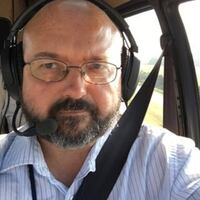Four times a year, Dayton Power & Light inspectors take to the skies in helicopters to examine sections of the company’s total 11,000-plus miles of transmission lines.
A ride Wednesday in the Brookville area had been scheduled well before last weekend’s storms. With DP&L Program Manager Richard Penrod on board, helicopter pilot Reed Usrey flew some 65 to 100 feet above the ground, eyeing power lines for storm damage and for signs that tree growth is encroaching within 10 feet of utility poles and other DP&L infrastructure.
DP&L helicopters track lines from Wapakoneta to the Ohio River. Left unchecked, tree growth can be fast and relentless, said Mark Vest, DP&L director of operations. Inspections are crucial to making sure that vegetation and storm debris don’t impede the delivery of power.
“We routinely do this,” Vest said. “It’s part of our normal maintenance program. We go up and patrol all of our maintenance lines and make sure we don’t have any issues out there.”
Inspectors look for vegetative growth, encroachments and other problems on private and public property. Inspectors will follow up on the ground after flights when necessary.
“We essentially just ride out on our right-of-ways where we have our equipment,” Vest said. “And we patrol it for whatever issues we might have.”
Why not use drones or unmanned aerial vehicles (UAVs)? Vest and others say helicopters offer greater control.
DP&L corporate owner AES Corp. uses UAVs all over the world, Vest said. But in the United States, regulations for UAV flights have mandated that operators maintain clear line of sight, keeping the drone in view at all times, he said.
“Those regulations are starting to relax,” Vest said. “But it’s not quite there. And it’s a whole lot easier to put a person in a helicopter, who can see in real time.”
“Drones cannot be used pretty much in the city,” Penrod said. “You can’t just pass the drones, start on this line, and go to the end and report. You have to stay in contact with them in line of sight. It would take a lot longer and be very cost-ineffective.”
When the weather is good, as it was Wednesday morning, Usrey said his job offers the best views.
He flew low, seemingly skirting tree tops, giving passengers a close view of line conditions.
“The only traffic we have (at this altitude) is birds,” Usrey said.
Vest said DP&L strives to work with property owners on trees that need to be trimmed. In some cases, DP&L can even remove lines so that tree trimmers can safely work. “We’ll get that wire out of the way.”
The utility asks that owners survey their property on a regular basis. If owners see a tree that’s diseased or dying, deal with it, he advises.
“In recent years, the majority of our outages are being caused by trees that we could have gone through on our trimming cycle before,” Vest said. “It might be a tree where, if the wire’s here, the tree is 40 feet that way, but it’s a 60-foot-tall tree.”
Home owners are responsible for keeping their service wire, the line going directly to homes, clear, he said.
About the Author
